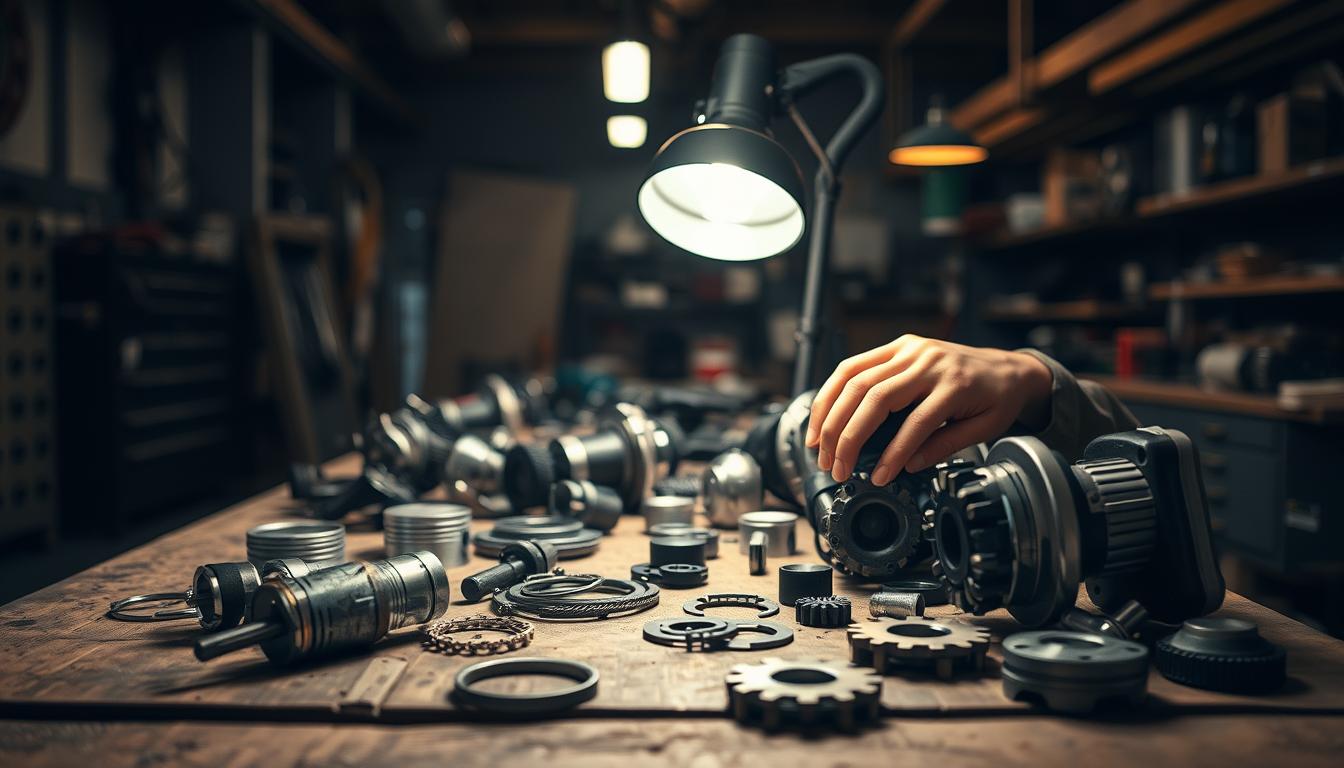Ever wondered why some riders swear by their bike’s performance while others face constant breakdowns? The secret often lies in the chain and sprocket sets they choose. These components are crucial for smooth power transmission and overall bike efficiency.
Investing in high-quality parts can save you time and money in the long run. Brands like D.I.D. and JT Sprockets are known for their durability and precision. For example, the 250R Ninja JT Chain and Sprocket set offers reliability at an affordable price point.
Choosing the right set ensures better performance and longevity. Whether you’re riding a Honda or another brand, genuine components make all the difference. Ready to learn how to pick the best options for your ride?
Key Takeaways
- High-quality chains and sprockets enhance bike performance.
- Brands like D.I.D. and JT Sprockets are trusted for durability.
- Genuine components ensure compatibility and reliability.
- Regular maintenance extends the lifespan of these parts.
- Investing in quality saves money on repairs in the long run.
Understanding Your Requirements and Component Quality
Have you ever thought about what makes your ride smooth and reliable? The answer often lies in the quality of your bike’s components. To ensure optimal performance, it’s essential to understand your specific needs and the standards that define durability.
Identifying Your Needs
Start by evaluating your bike’s mechanical requirements. The rear sprocket and front sprocket play distinct roles in power transmission. The rear component handles most of the load, while the front ensures smooth rotation. Knowing the difference helps you choose the right parts.
Consider the number of teeth on each sprocket. This design feature directly impacts performance and safety. A higher tooth count on the rear sprocket can improve acceleration, while fewer teeth on the front enhance top speed.
Assessing Durability and Testing Standards
Durability is a key factor when selecting components. Look for parts that have undergone rigorous testing. For example, RK has been a leader in developing sealed ring chains since the 1970s. Their products are tested during endurance races, ensuring they can withstand harsh conditions.
Always check for adherence to performance standards. High-quality materials and advanced manufacturing processes ensure longevity. Investing in tested components not only enhances performance but also reduces the need for frequent replacements.
Used Motorcycle Chain and Sprocket Sets: What to Look For
What separates a smooth ride from a bumpy one? It’s often the components you choose. When inspecting used parts, focus on essential features like wear patterns, alignment, and material quality. These factors determine whether the set will deliver reliable performance.
Recognising differences in types of kits is crucial. For example, Yamaha and Honda models often require specific configurations. A kit designed for a Honda CBR250R may not suit a Yamaha R3. Always check compatibility to avoid issues.

Understanding the distinction between front and rear components is also key. The front part ensures smooth rotation, while the rear handles most of the load. A balanced setup improves efficiency and reduces wear.
Here’s a quick comparison of popular kits:
| Brand | Model | Front Teeth | Rear Teeth | Material |
|---|---|---|---|---|
| Yamaha | R3 | 14 | 45 | Steel |
| Honda | CBR250R | 15 | 43 | Alloy |
Real product examples help illustrate design and functionality. For instance, the Yamaha R3 kit features a steel construction for durability, while the Honda CBR250R kit uses alloy for lightweight performance. Compare these options based on technical specs and proven reliability.
Investing in a quality kit ensures your ride remains smooth and efficient. Look for signs of wear, check compatibility, and choose components that match your bike’s needs. With the right setup, you’ll enjoy a hassle-free experience on the road.
Evaluating Chain Options and Drive Technology
When it comes to enhancing your ride, have you considered the impact of your bike’s drive components? The right choice can significantly improve performance and reduce maintenance needs. Let’s explore two standout options: Japanese-made D.I.D chains and advanced sealed ring technology.
Japanese-Made D.I.D Chains
D.I.D chains are renowned for their precision and durability. Made in Japan, these chains are crafted with high-quality materials and advanced engineering. They offer excellent brake compatibility and smooth gear transitions, making them a favourite among riders.
One of the key features is their resistance to wear and tear. This ensures a longer lifespan, saving you money in the long run. Whether you’re tackling rugged terrains or cruising on highways, D.I.D chains deliver consistent performance.
Advances in Sealed Ring Chain Technology
Sealed ring chains, pioneered by RK, have set a benchmark in drive technology. These chains are designed to reduce friction and enhance efficiency. Their innovative design includes precision-engineered cams that improve power transmission.
Tested in endurance races, sealed ring chains prove their reliability under extreme conditions. They also require less maintenance, making them a practical choice for everyday riders. With their advanced features, these chains are a game-changer in the industry.
Choosing the right chain depends on your riding style and needs. Both D.I.D and sealed ring chains offer unique benefits. Evaluate them based on performance, durability, and cost to find the best fit for your bike.
Selecting the Right Sprocket Materials and Types
Choosing the right materials for your bike’s components can make or break your ride. The type of sprocket you select impacts durability, performance, and compatibility. Let’s explore the two most popular options: steel and alloy sprockets.
Steel Sprockets for Long-Lasting Performance
Steel sprockets are known for their durability and strength. Brands like RK use advanced materials like SCM-415 Alloy Steel and S45C Carbon Steel. These materials undergo heat treatment and carburizing processes to enhance their lifespan.
This makes them ideal for heavy-duty applications, especially in dirt or off-road conditions. They resist wear and tear, ensuring your clutch system remains efficient for longer periods.

High-Performance Alloy Sprockets
Alloy sprockets are lighter and designed for high-performance needs. They are perfect for racing or competitive riding where speed and agility are crucial. Unlike steel, alloy sprockets reduce overall weight, improving acceleration and handling.
However, they may require more frequent replacements due to their lower durability. For everyday use, OEM alloy sprockets offer a balance between performance and cost-effectiveness.
| Material | Durability | Weight | Best Use |
|---|---|---|---|
| Steel | High | Heavy | Off-road, heavy-duty |
| Alloy | Moderate | Light | Racing, high-performance |
Whether you choose steel or alloy, ensure the sprocket matches your bike’s specifications. Proper selection enhances performance and reduces maintenance needs. Consider your riding style and environment to make the best choice.
Compatibility with Your Motorcycle and Riding Style
Are you struggling to find the perfect fit for your ride’s components? Ensuring compatibility is crucial for optimal performance and safety. Whether you ride a Honda, Yamaha, Kawasaki, or Suzuki, matching the right parts to your bike’s specifications is essential.
Considerations for Honda, Yamaha, and Kawasaki Models
Each brand has unique requirements. For example, Honda models often need specific sprocket configurations to match their motor and exhaust systems. Yamaha bikes, on the other hand, may require lighter components for better handling.
Kawasaki riders should focus on durability, especially for off-road or high-speed riding. Suzuki models, known for their versatility, often benefit from balanced setups that enhance both acceleration and top speed.

Rear vs Front Sprocket Configurations
The rear sprocket handles most of the load, while the front ensures smooth rotation. Choosing the right size and material can significantly impact your bike’s performance. For instance, a larger rear sprocket improves acceleration but may reduce top speed.
Here’s a quick comparison of common setups:
- Rear Sprocket: Larger size for torque, smaller for speed.
- Front Sprocket: Smaller size for acceleration, larger for cruising.
Proper alignment and secure sprocket bolts are also critical. Loose bolts can lead to misalignment, causing wear and reducing efficiency. Always check the fitment of mounting hardware to ensure a snug and secure connection.
For more detailed guidance on selecting the right components, check out this beginner’s guide to motorcycle chains.
Pricing and Finding Value with Tested Components
How do you ensure you’re getting the best value for your bike’s components? It starts with understanding what influences pricing and how to balance quality with your budget. Let’s break it down.
Material quality is a major factor. High-grade steel or alloy components, like those from trusted brands, often cost more but last longer. Production technology also plays a role. Advanced manufacturing processes, such as heat treatment, enhance durability and justify higher prices.

Testing standards are another key consideration. Look for parts that have been rigorously tested in real-world conditions. For example, RK’s sealed ring chains are endurance-tested, ensuring they can handle extreme stress. This level of reliability often comes at a premium but saves money in the long run.
Here’s a quick cost comparison:
- CRF150 Set: $150 – $200, ideal for light-duty use.
- Honda XR500 Set: $250 – $300, designed for heavy-duty performance.
Balancing performance with budget is crucial. If you’re a casual rider, a mid-range set might suffice. For competitive or off-road use, investing in premium components ensures better engine efficiency and reduced wear on bearing systems.
Don’t forget to check for discounts or warranties. Reputable suppliers often offer deals, especially on older models. A warranty can provide peace of mind, covering replacements if issues arise.
Finally, verify the testing records of the components you’re considering. This ensures you’re getting parts that meet industry standards. By doing your research, you can find high-quality components that fit your budget and enhance your ride.
Tips for Buying in Australia: Trusted Suppliers and Local Trends
Navigating the Australian market for bike components can be tricky, but with the right tips, you’ll make informed decisions. Understanding local pricing and supplier reputation is key to finding reliable parts that suit your needs.
Understanding Local Market Prices
Prices for components like rear sprockets and valve systems can vary across regions. In Australia, factors like import costs and demand influence pricing. For example, induction hardened parts often cost more due to their durability and advanced manufacturing processes.
Comparing prices from multiple suppliers helps you identify fair deals. Look for seasonal discounts or clearance sales, especially on high-demand items. Remember, a lower price doesn’t always mean better value—quality should always come first.

Evaluating Supplier Reputation and Warranty
Choosing a trusted supplier ensures you get genuine components. Research customer reviews and ratings to gauge reliability. Reputable brands often provide warranties, which can save you money on replacements or repairs.
Look for suppliers who offer detailed product descriptions and testing records. For instance, components with stroke treatments should come with proof of endurance testing. This guarantees they’ve been rigorously evaluated for performance.
Here’s a quick checklist when evaluating suppliers:
- Check for positive customer feedback and ratings.
- Verify if they offer warranties or return policies.
- Ensure they provide detailed product specifications.
As the market evolves, electric bikes are gaining traction in Australia. For insights into this growing trend, explore this guide on electric motorcycles.
Conclusion
Making the right choice for your bike’s components ensures a smoother, more reliable ride. Throughout this guide, we’ve highlighted the importance of selecting quality parts tailored to your specific needs. From technological advancements to rigorous testing standards, every detail matters.
Compatibility, material quality, and supplier reputation are critical factors to consider. Whether you’re riding a Kawasaki or a scooter, investing in durable components like rubber-sealed parts can enhance performance and longevity. Regular maintenance, using the right tool, also plays a key role in keeping your ride in top shape.
As you explore your options, compare features and prices to find the best fit. A new set of components, designed for your bike’s seat and frame, can make all the difference. Choose wisely, and enjoy a fast, hassle-free experience on the road.




